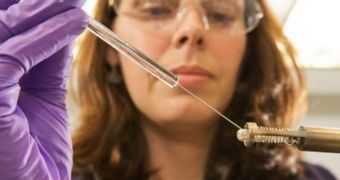For 2012, NASA plans to send a mobile laboratory to Mars, in an attempt to determine whether life ever existed on the Red Planet, or if it's still there today. Officials at the space agency have now announced that the new experiment has been accepted aboard the laboratory. Developed by experts at the NASA Goddard Space Flight Center (GSFC), the new payload will be included in the Sample Analysis at Mars (SAM) instrument, aboard the Mars Science Laboratory (MSL) rover.
“Mars was a lot different 3-1/2 billion years ago. It was more like Earth with liquid water. Maybe life existed back then. Maybe it has persisted, which is possible given the fact that we've found life in every extreme environment here on Earth. If life existed on Mars, maybe it adapted very much like life adapted here,” Jennifer Eigenbrode, a scientist working at the GSFC headquarters, in Greenbelt, Maryland, explains. She is also the one who developed the new SAM experiment.
If the instrument finds large organic molecules, then Eigenbrode's experiment will come into play. It will be able to determine if the molecules are made up of smaller constituents, such as carbohydrates, lipids, proteins, and nucleic acids, which are the basic units of life. “Our experiment preserves information on how these molecules formed. What we'll get are key observations that tell us about organic carbon sources and processing on Mars – shedding light on the planet's carbon cycle,” the expert reveals.
She also takes great pride in the fact that her experiment has been accepted on SAM. Experts reveal that this is the most complex instrument ever to have flown on another planet. It is made up of a gas chromatograph, a quadruple mass spectrometer, and a tunable laser spectrometer. However, it is only one of the ten scientific payloads on the small, car-sized MSL, which has been renamed Curiosity.
“With the addition of Jennifer's chemical toolkit, the range of organic molecules that SAM can detect has been expanded with no hardware modifications. It provides a promising path to contribute to our understanding of the biological potential on MARS,” the mission's principal investigator, Paul Mahaffy, says.
“When I began working on my concept in early 2009, I thought it might be suitable for a future Mars mission, perhaps in 2016. I never thought that it would fly so soon on SAM. I believe we have really enhanced the capabilities of SAM should it find organic material. What I really want now is to find macromolecules on Mars,” Eigenbrode concludes.

 14 DAY TRIAL //
14 DAY TRIAL //